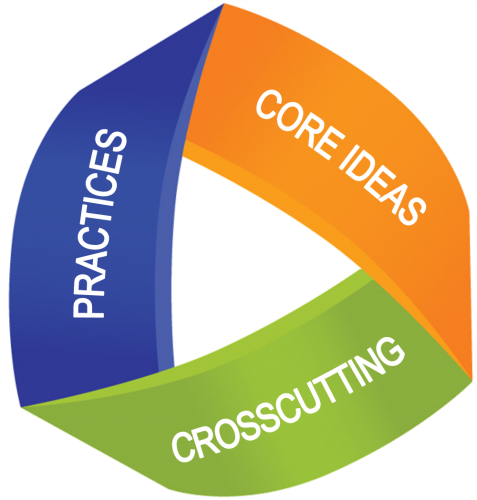Activity 4 description: Learners explore the concept of sustainability by examining the United Nations’ 17 Sustainable Development Goals, while also taking a look at some jobs involved in ensuring forest sustainability.
To get PLT’s Green Jobs: Exploring Forest Careers unit, purchase a copy from Shop.PLT.org or find information about an in-person workshop in your area.
Below are some supporting resources for this activity, including the Worksheets from the guide (also known as Student Pages).
STUDENT PAGES 
Download the copyright-free student pages that are included with this activity:
Worksheet_Forest Sustainability
(PDF)
Worksheet_United Nations Sustainable Development Goals
(PDF)
ADDITIONAL RESOURCES 
The following tools and resources may be used to enhance the activity.
-
NGSS Toolkit for Green Jobs: Exploring Forest Careers
 Download this PLT Green Jobs NGSS Correlations Toolkit. The Toolkit includes guiding questions, a list of science connections, and explicit NGSS correlations for each activity. Each is organized around the three dimensions of science, making it useful for educators even if their state has not adopted NGSS.
Download this PLT Green Jobs NGSS Correlations Toolkit. The Toolkit includes guiding questions, a list of science connections, and explicit NGSS correlations for each activity. Each is organized around the three dimensions of science, making it useful for educators even if their state has not adopted NGSS.
-
The State of the World’s Forests 2020
The Food and Agriculture Organization of the United Nations (FAO) has monitored the world’s forests at 5 to 10-year intervals since 1946. The State of the World’s Forests 2020–Forests, Biodiversity and People, examines the contributions of forests, and of the people who use and manage them, to the conservation and sustainable use of biodiversity. For the first time, this edition is a joint effort between two United Nations entities: FAO and the United Nations Environment Programme (UNEP).
In addition, this interactive report contains the main findings of the Global Forest Resources Assessment 2020 (FRA 2020). FRA 2020 examines the status of, and trends in, more than 60 forest-related variables in 236 countries and territories in the period 1990–2020. The information provided by FRA presents a comprehensive view of the world’s forests and the ways in which the resource is changing.
-
Career Profile Cards
Explore jobs in the environment, natural resource, outdoor recreation, and renewable energy sectors with these Career Profile Cards, developed by the Pacific Education Institute. The cards highlight voices of individuals in those careers. Learn about the day-to-day, career pathway, and tips and tools of the trade from an Assistant Forester, Salmon Habitat Restoration Manager, Water Quality Biologist, and even the owner and founder of a Kayak company.
-
PLT Green Jobs Youth Personality Quiz
Project Learning Tree has launched an interactive quiz that allows youth to answer a few simple questions online and receive recommendations for a rewarding green career path that suits their personality. It’s fast, easy, and fun to do! — perfect for youth ages 12-25 looking to learn about what it takes to perform jobs in sustainability, forestry, and conservation. Try the quiz yourself at www.plt.org/greenjobsquiz.
-
PLT’s 12 Green Job Fact Sheets
Learn more about the wide array of jobs related to forests with PLT’s 12 Green Jobs Fact Sheets, which highlights the following green jobs: Forester, Environmental Educator, GIS Specialist, Indigenous Relations Specialist, Forestry Technician, Park Ranger, Hydrologist, Silviculture Technician, Urban Forester, Machine Operator, Wildlife Biologist, and Sustainability Manager. Green jobs offer opportunities for people with diverse backgrounds, skills, interest areas, and personal qualities. Youth and adults alike might be surprised at the range of green career opportunities. These jobs help sustain forest ecosystems and ensure that forest products are produced in the most sustainable way possible also ensure that wildlife habitat is conserved, trees are replanted, and workers are treated fairly.
-
Podcast Series: Global GoalsCast
Learn more about the current progress of the United Nations’ Sustainable Development Goals (SDGs) in this episode from the podcast series Global GoalsCast. UN Foundation discusses how countries and cities – from Uganda to New York – are measuring their SDG progress with the help of policymakers, entrepreneurs, and individuals. This podcast shares the stories of individuals, companies, and organizations working towards a more sustainable world.
-
Podcast Series: Center for Global Development
Learn more about the book “Why Forests? Why Now? The Science, Economics and Politics of Climate Change” in this episode from a podcast series created by the Center for Global Development (CGD). CGD Senior Fellow, Frances Seymour, discusses forests, the Paris climate agreement, and the sustainable development goals – indicating the importance of protecting tropical forests for meeting half of the listed SDGs set forth by the United Nations.
-
Forest Sustainability Reporting in the United States
Read how the United States Forest Service tracks domestic and international forest sustainability goals through the Service’s Sustainability Assessment Program. Using an internationally agreed-upon set of 54 forest sustainability indicators known as the Montreal Process Criteria and Indicators, USFS has created reports for each indicator, with topics including biodiversity conservation, forest fires, and the many benefits derived from forests.
-
iNaturalist
iNaturalist is a species identification app that allows users to record their observations of living things by way of taking photos and appending GPS coordinates to their discoveries. Each user has their own profile and can follow others to keep a tab of what others are posting, or share what they have photographed. The app also facilitates connections with thousands of scientists to help users identify the species they have observed.
Another exciting aspect of iNaturalist is that users can contribute their photos and data and participate in a number of citizen science projects. You can find a list of some of these projects here or click on “find your location” using this map to see the observations in your area. You can also develop your own for your school or local community!


 Download this
Download this